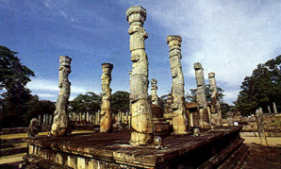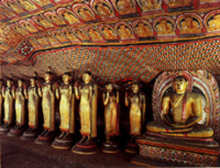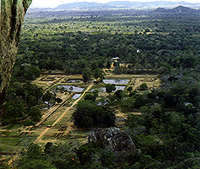|
|
|
|
SRI LANKA |
 |
Five centuries before Christ, Sri Lanka was
a land throbbing with vitality and a well-ordered civilization.
Cities, palaces, reservoirs and parks, temples, monasteries, monuments and works of art
bore testament to the character, imagination, culture, philosophy and faith of the people
of Sri Lanka, the Resplendent Land. |
|
Vestiges of this ancient civilization are abundantly extant today and may
be reached from Colombo in a comfortable morning's drive through verdant countryside,
flourishing green paddy fields, acres of coconut palms and alongside deep jungle in which
elephant and leopard roam. Recorded history emerges from the mists sometime after the
advent of the Sinhala, apparently before the Century BC. These were, it is believed, a
North Indian people of Aryan, ancestry, who settled first in the north-central plains and
raised in the Island an agricultural elite whose feats of irrigation excite wonder to this
day and founded a system of government that proved viable for more than two thousand
years.
By the middle of the 3rd Century BC the fame of the capital, Anuradhapura, was known as
far abroad as the Mediterranean. Less than three centuries later a Sinhala trade
delegation was presenting its credentials in Rome to Claudius Caesar, and Pliny, the
Elder, spoke with them. Three centuries after that as far-flung a connexion had been
established eastwards, with China.
In 247 BC occurred the greatest single event in Sri Lanka's history, when through the
missionary labours of the monk Mahinda, son of the Buddhist Emperor Ashoka of India, the
Island's king, court and commoners were converted to Buddhism. In Sri Lanka this pristine
religion found a permanent home and for Buddhists everywhere the Island became a place of
especially sanctity, a repository of holy relics, orthodox doctrine and a goal of
pilgrimage.
About the same period began the Dravidian invasions which for a thousand five hundred
years were to fall upon the Island in wave after wave While the country absorbed much of
the Hindu culture and all of the Hindu people these invasions left behind, it remained a
Buddhist State under Buddhist rule.
Under the Dravidian pressure, however, the capital, after having survived in Anuradhapura
up to the 10th Century, had to be withdrawn again and again: to Polonnaruwa, to the rocky
forests around Kurunegala, to Kotte near Colombo, finally to the Kandyan hills where the
Sinhala Kingdom made its last stand.
|
128 miles (205 km) from Colombo is Anuradhapura, Sri Lanka's first capital
founded about the 4th century BC. According to the Mahavansa, the Sinhala Buddhist
chronicle, the city was a model of planning.
|
 |
|
Precincts were set aside for huntsmen and scavengers and even heretics and
foreigners. There were hostels and hospitals, separate cemeteries for high and low castes.
A water supply was assured by the construction of reservoirs.
Anuradhapura was to continue for over thousand years as the national capital. But
internecine struggles for the royal succession grew, and it became more and more
vulnerable to the pressures of South Indian political expansion. The city was finally
abandoned and the capital withdrawn to more secluded areas.
But the monuments of Anuradhapura's heyday survive, surrounded by the solemn umbrage of
trees, scions of an ancient parkland.
MIHINTALE
Over 7 miles east of Anuradhapura is Mihintale regarded as the cradle of Buddhism in
Sri Lanka. The rock is riddled with shrines and rock dwellings. A grand stairway of 1,840
steps made of granite slabs 15' wide, leads to the summit, from where one could get a
splendid view of the surrounding countryside.
|
POLONNARUWA
35 miles (216 km) from Colombo and south east of Anuradhapura is the island's medieval
capital. When early in the 11th century AD Anuradhapura suffered one of the worst of its
many Indian invasions, Polonnaruwa became the next seat of rule. Today's ruins, however,
belong almost exclusively to the reigns of two kings.
|

|
The city in its day was fortified with three concentric walls, beautified
with parks and gardens and sanctified by many a shrine and sacred place. The city itself,
as well as the surrounding plain was watered by a unique irrigational complex known as the
Sea of Parakrama (Parakrama Samudra) so vast was its scale.
SIGIRIYA
Sigiriya was no mere fortress, gloomy and forbidding. At the brief height of its glory
- it was a royal citadel for more than 18 years, from 477 to 495 A.D. and one of the
loveliest that have graced this land.
There are many interpretations of the Sigiriya period, history replete with legend, love
and betrayal. But one story remains, the story of Kasyapa (477 - 495 A.D.) its creator,
King with an artist's soul. Bards have written about him and plays and films have tried to
capture his personality.
 |
Kasyapa
left Anuradhapura and built for himself at Sigiriya, a palace an city modelled in the
mythical abode of "Kuvera" God of Wealth. He gave form to his dreams of
grandeur. Eighteen years later, his half-brother Moggallan challenged him with an army. By
one of those momentary mistake of judgement that changes the course of history, Kasyapa
thought he was alone in battle, raised his dagger and slew himself.
|
In a sheltered pocket on the western face of the Sigiriya rock, approached
by a spiral stairway, are the famous frescoes. Epigraphical evidenced refers to the
existence of 500 such portraits, but only 19 remain today.
On the western and northern sides of the steep rock face runs a gallery or pathway which
provides access to the seemingly inaccessible summit. Shielding this pathway is a 9 1/2
ft. plaster wall,. So highly polished, that even today, after fifteen centuries of
exposure to sun, wind and rain, one can see one's reflection on it. Hence the name
"Mirror Wall".
On the polished surface are the Sigiri Graffit... recorded by processions of visitors to
the rock in the past.
The summit of the rock is nearly three acres in extent. The outer wall of the palace which
is the main building was constructed on the very brink of the precipice. There were
gardens, cisterns and ponds laid out attractively.
The pleasure garden of the western side of the rock is studded with ponds, islets,
promenades and pavilions. Some and surface drainage systems have been discovered during
excavations. The wall abutting the moat encircling the fortress is one of the most
arresting features.
|
 |
Twelve
miles from Sigiriya is Dambulla, a vast isolated rock mass 500 ft. high and a mile
round the base. Here is found the famous rocktemple dating to the first century B.C. The
caves of Dambulla sheltered the kind during his 14 years of exile from Anuradhapura. When
he regained the throne, he caused to be built the most magnificent of rock-temples of this
island.
|
The view from the top of thisrock is breathtaking 350 ft. above are a
series of five caves turned into shrines.
In the first cave is recumbent image of the Buddha 47 ft. long, cut out of the rock. There
are images of deities associated with Buddhism. The frescoes on the walls and ceiling
could be dated to the 15th - 18th centuries. In the second cave, the finest and the
largest of all, are not less than 150 life-size statues of gods. There are numerous images
of the Buddha as well. The ceiling too is covered with frescoes which depict great events
in the life of the Buddha, and landmarks in the history of the Sinhala people. |
|
|
|
| |
Dubai , Mauritius , Nepal , Singapore |
Top |
| |
|
|